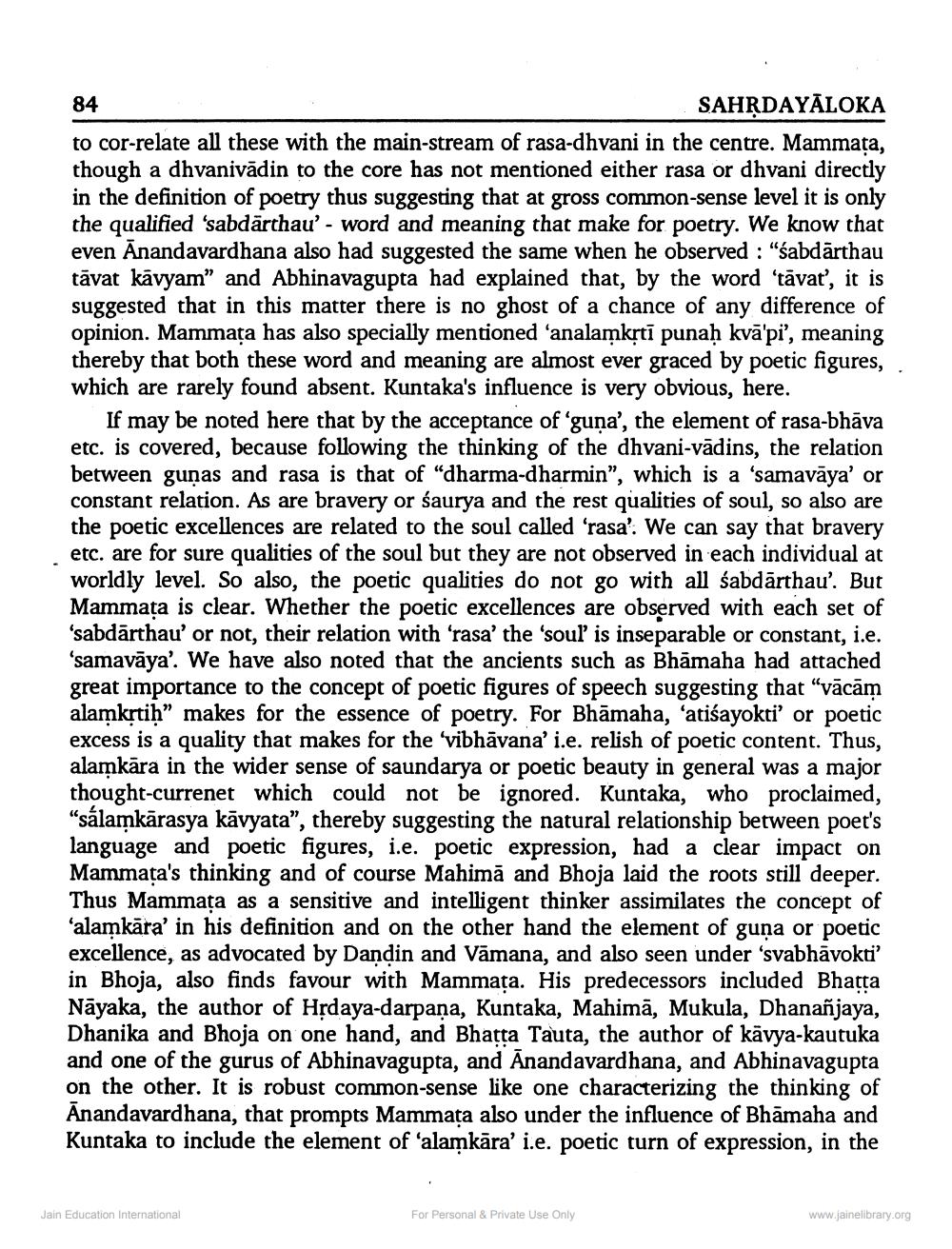________________
84
SAHRDAYĀLOKA
to cor-relate all these with the main stream of rasa-dhvani in the centre. Mammata, though a dhvanivādin to the core has not mentioned either rasa or dhvani directly in the definition of poetry thus suggesting that at gross common-sense level it is only the qualified 'sabdārthau'- word and meaning that make for poetry. We know that even Ānandavardhana also had suggested the same when he observed : "śabdārthau tāvat kävyam” and Abhinavagupta had explained that, by the word 'tāvat', it is suggested that in this matter there is no ghost of a chance of any difference of opinion. Mammața has also specially mentioned 'analamkrti punaḥ kvā'pi', meaning thereby that both these word and meaning are almost ever graced by poetic figures, which are rarely found absent. Kuntaka's influence is very obvious, here.
If may be noted here that by the acceptance of ‘guna', the element of rasa-bhāva etc. is covered, because following the thinking of the dhvani-vādins, the relation between gunas and rasa is that of "dharma-dharmin", which is a 'samavāya' or constant relation. As are bravery or saurya and the rest qualities of soul, so also are the poetic excellences are related to the soul called 'rasa'. We can say that bravery etc. are for sure qualities of the soul but they are not observed in each individual at worldly level. So also, the poetic qualities do not go with all śabdārthau'. But Mammata is clear. Whether the poetic excellences are observed with each set of 'sabdārthau' or not, their relation with 'rasa' the 'soul is inseparable or constant, i.e. 'samavāya'. We have also noted that the ancients such as Bhāmaha had attached great importance to the concept of poetic figures of speech suggesting that "vācām alamkrtih" makes for the essence of poetry. For Bhāmaha, 'atiśayokti' or poetic excess is a quality that makes for the 'vibhāvana' i.e. relish of poetic content. Thus, alamkāra in the wider sense of saundarya or poetic beauty in general was a major thought-currenet which could not be ignored. Kuntaka, who proclaimed, “sálamkārasya kāvyata”, thereby suggesting the natural relationship between poet's language and poetic figures, i.e. poetic expression, had a clear impact on Mammata's thinking and of course Mahima and Bhoja laid the roots still deeper. Thus Mammata as a sensitive and intelligent thinker assimilates the concept of 'alamkāra' in his definition and on the other hand the element of guna or poetic excellence, as advocated by Dandin and Vamana, and also seen under 'svabhāvokti?
also finds favour with Mammata. His predecessors included Bhatta Nāyaka, the author of Hrdaya-darpana, Kuntaka, Mahimā, Mukula, Dhananjaya, Dhanika and Bhoja on one hand, and Bhatta Tauta, the author of kávya-kautuka and one of the gurus of Abhinavagupta, and Anandavardhana, and Abhinavagupta on the other. It is robust common sense like one characterizing the thinking of Anandavardhana, that prompts Mammata also under the influence of Bhāmaha and Kuntaka to include the element of 'alamkāra' i.e. poetic turn of expression, in the
Jain Education International
For Personal & Private Use Only
www.jainelibrary.org




